Part I: Opening Situation
Part II: Battle of Champaubert
Part III: Battle of Montmirail
Note: We continue our series on the Six Days Campaign of 1814 started in EE&L #7. Our last issue covered the Battle of Montmirail, fought on February 11, in which Napoleon defeated Sacken's and Yorck's command. The Battle of Chateau-Thierry is a continuation of the Allied retreat from Montmirail. As seen in part II of this series, Napoleon, deeply involved in his gamble to destroy Blucher's widely seperated Army of Silesia, had every intention of reaping the maximum advantage from his success at Montmirail Marchais. He had ordered Macdonald, now on the far (north) side of the Marne River, to capture Chateau-Thierry and deny the enemy the use of its bridge over the river.
On the 12th, the Emperor planned to pursue Sachen and Yorck with everything he had available. He hoped to completely destroy these two commands, but that depended on Macdonald's ability to capture the bridge at Chateau-Thierry. Unlike the previous articles in this series, there is no specific order of battle for this battle since it was a continuous rear-guard action in which only a portion of the Allied formations took part.
The Battle of Chateau-Thierry as per the French accounts
by Jean A. Lochet
Olssufiev's small Russian corps had been destroyed at Champaubert on February 10. Sacken's three Russian corps were defeated and seriously shaken and Yorck's Prussian I Corps repulsed at Montmirail on February 11. Yet in spite of his second victory at Montmirail-Chablais, Napoleon still evaluated his position as critical. He estimated that a total of some 11,000 Prussians and Russians had been eliminated and 47 guns captured at Champaubert and Montmirail. But the Marne valley was still under the control of Sacken and Yorck, and their combined commands still mustered some 30,000 men versus less than 15,000 for the French. In addition, on the French rear, the audacious Blucher was no doubt impatient to start moving from Etoges with his 20,000 fresh troops and 80 guns to help the rest of his command.
Most likely, Blucher was going to easily brush aside Marshal Marmont's 4,000 recruits (see map #3). Finally, during the same three-day period in the south, the Seine River had been abandoned to Schwarzenberg's large Army of Bohemia, further compounding the pressure on the French. Already an alarmed Marshal Victor was calling for Napoleon to return.
With all that in mind, how was it possible to conceive of pushing further north away from the Seine toward Chateau-Thierry with the few soldiers who virtually represented the last resources of France? Yet Napoleon did not and could not hesitate. He had to destroy Sacken and Yorck in order to reclaim a superior position.
At 8:00 a.m. on February 12, Napoleon sent his troops straight north toward Chateau-Thierry. Marshal Mortier with the Young Guard and the Guards of Honor moved to Fontenelle. Marshal Ney with the Guard cavalry started to move at dawn with Napoleon and his staff, Christiani's Division and the artillery reserve toward Viels-Maisons where a reserve was left; then moved toward Chateau-Thierry by the road to Vifford. What was left of Ricard's Division - exhausted by the combat at Marchais - was left at Montmirail.
Meunier's Division and four battalions of Friant's Old Guard Division moved along by side roads, seeking the enemy.
Two miles beyond Fontenelle, the vanguard came in contact with the Prussian outposts which fell back upon their reserves. These were promptly attacked by the duty squadrons supported by two chasseur battalions of the Old Guard and a battery. The Prussians fell back.
Around 1:00 p.m., the Guards of Honor came in contact with Horn's Brigade that had taken position on the slopes of the Caqueret hills, behind the Viffort brook, barring the road to Chateau-Thierry. The Prussians held a strong position covered by numerous skirmishers. The brook was sunken between two wooded hills that were linked by a narrow bridge. The Emperor was quick to find the weak point in the Prussian deployment. He sent 200 grenadiers to seize the only breach the Prussian gunners had neglected to cover. That assault was immediately followed by an attack up the hills by the six battalions of the Old Guard supported by the rest of the infantry. The attack was successful.
At the same time the Guard cavalry, led by the Young Guard Dragoons, attacked at the trot the Prussian right flank. The Prussian infantry formed square. Despite increasing fire, the cavalry advanced at a gallop and broke the three squares insuccession. This attack cut-off the enemy's retreat route toward Epernay.
Yorck's corps was now shattered and infull retreat. Jurgass' cavalry and Sacken fled to Chateau-Thierry, pursued by General Belliard and the duty squadrons (of the Imperial Guard Cavalry, Napoleon's escort), while General Petit and two battalions of grenadiers drove Prince William of Prussia and his reinforcements off the Nesle plateau and into the city. General Heidenreich's Brigade consisting of two Russian regiments (the Tambovand Kostroma, a total of only two battalions) fought a delaying action as the rest of Yorck's and Sacken's commands were retreating across the river. These two battalions formed square and kept the French at bay with their musketry. But, heavily out-numbered, they were ultimately broken and forced to surrender. General Heidenreich was captured and three guns were taken.
The enemy fled across the Marne bridge in disorder under the fire of Griois' artillery, leaving 3,000 prisoners [1], 20 guns and a vast number of wagons. For a cost of about 600 casualties, the French inflicted 1,250 casualties on the Prussians and 1,500 casualties on Sacken's Russians.
The retreating Prussians were able to destroy the bridge over the Marne at Chateau-Thierry which Macdonald had failed to seize. In the hours that followed, Napoleon's sappers, helped by the Sailors of the Guard (who are not to be confused with the Marines), repaired the bridge as Napoleon had no bridging train. As a result, it was 24 hours before Mortier and the cavalry could resume their pursuit. By that time, the Allies had placed another river (the Ourcq ) between themselves and the pursuing French.
Mortier pursued the defeated Allies as they retreated toward Soissons, taking with him Christiani, Colbert, the Guards of Honor, some artillery and sappers. The Emperor, mean while, returned to Montmirail.
In spite of his third success against Blucher's forces, Napoleon was bitterly disappointed. The results fell short of his expected goal as he had hoped to completely destroy Yorck's and Sacken's corps. Macdonald had scarcely advanced eastward and failed to grasp the strategic importance of retaking Chateau-Thierry and the invaluable bridge over the Marne. If Macdonald had captured the Chateau-Thierry bridge, with their retreat route to Epernay cut off by the Guard cavalry, Yorck's and Sacken's [2] defeated commands would have been forced to surrender or to fight another battle under very unfavorable conditions. Instead, they were able to escape.
The Battle of Chateau-Thierry, like Montmirail, had been won by the Guard's outstanding performances. In a dispatch to Savary, Napoleon wrote: "My foot and horse Guard covered them selves with glory. The dragoons distinguished themselves with a performance comparable to those romances of the Age of Chivalry in which a single knight would take three or four hundred adversaries at once. The enemy seemed struck by a singular terror."
[3]
Larger Map (slow: 156K)
During that time, Blucher, most likely thinking that Sacken and Yorck had defeated Napoleon, continued his march from Vertus. On February 12 he was at Bergeres, and on the 13th he reached Champaubert after pushing back Marmont, who had tried to make a stand at the strong position of Etoges. It was Marmont's turn to call for help.
[Note: Because of the growth of the town of Chateau-Thierry and its suburbs, no pictures were taken on the Nesles plateau and in the vicinity of Chateau-Thierry. The battle sites are no longer what they were in 1814, and most have simply disappeared.]
De Segur, Comte Philippe, Du Rhin a Fontainebleau, Nelson, Paris
Houssaye, 1814, Perrin, Paris, 1888.
Lachouque, Commandant Henri, translated by Anne S.K. Brown, Anatomy of Glory, Brown University Press, 1961.
Chandler The Campaigns of Napoleon.
Numerous miscellaneous notes from French Archives (Archives Guerres and Bibliotheques Nationale).
Mikhailofsky-Danielefsky, A. History ofthe Campaign of France in the Year 1814, 1992 reprint by Ken Trotman Ltd.Cambridge. England.
Zweguintov L'Armee Russe, Paris.
by George Nafziger
At the break of dawn on February 12, Sacken's command passed through the Prussian lines at Montfaucon. Sacken placed a brigade containing the Tambovand Kostroma Regiments, under General Heidenreich, on the left bank of the Marne. Prussian General Katzler occupied the heights by Montfaucon. Behind him stood the 1st and 7th Prussian Brigades as well as the Prussian Reserve Cavalry of General Jurgass.
Around 9:00 aim. [1] Napoleon sent St.Germain's Cavalry Division, and Friant's 1st Old Guard Division, less 1st Brigade, to Viels-Maisons in case Feldmarschal Blucher sought to move through Montmirail. With his remaining troops he advanced down the road through Rozoy toward Chateau-Thierry. General Christiani now commanding the 2nd Old Guard Division in Michel's place, and Colbert led the advance under the command of Marshal Mortier. [2].
As they arrived before Caquerets they encountered General Katzler's forces deployed in battle order across the heights behind the stream. Katzler was positioned to contest Napoleon's march down the road to Chateau-Thierry. The 1st and 2nd battalions of the 2nd East Prussian Infantry Regiment stood in the first line, with the skirmishers of the four musketeer battalions of the 1st and 2nd East Prussian Infantry Regiments, under Majorvon Stockhausen, posted in the village of Viffort and covering the ground before it.
Katzler's troops delayed the advancing French in this position for an hour. However, when the French began turning their flanks they were obliged to withdraw. From their initial position they pulled back to a second defile defended by General von Horn's 7th Brigade.
Earlier that morning, Napoleon had rallied General St. Germain's column of 2,400 cavalry, forming the 1st, 2nd and 4th Cavalry Corps, at Viels Maisons. [3] These men were recently remounted. Acting on Napoleon's orders, Macdonald had dispatched them in pursuit of Sacken's rearguard. Napoleon had detached Friant's 1st Old Guard Division and posted them in Viels-Maisons, except for four battalions of Old Guard Grenadiers, which he sent to guard the approaches from Sezanne.
That done, Napoleon turned the remainder of his army toward Chateau-Thierry, marching down the road to Rozoy, with the goal of throwing back any Allied formations he encountered on the right of the main road to Paris. His eclaireurs, which preceded his advance, found the road littered with abandoned vehicles and caissons.
When Napoleon arrived at the defile at Cacquerets, in the company of Ney and the remaining cavalry, he found the Prussians deployed in line of battle on a plateau which stood behind a stream and blocked the road from Montmirail to Chateau-Thierry. [4] It was at that moment that Katzler abandoned his initial positions at Caquerets.
The Prussians saw French infantry advancing down both sides of the road from Viffort. Marshal Mortier's cavalry marched on the right and another force of cavalry accompanying Napoleon advanced up the left from the Caquerets heights. [5]
The French advance was covered by a skirmish line that quickly engaged the Prussian skirmishers. The right flank of the Prussian line was covered by the skirmishers of the 2nd Silesian and the Leib-Grenadier Battalions. The left flank was covered by skirmishers from the Leib Infantry Regiment. The left flank was fixed on the Petites Noues farm and a small woods.
The French brought two cannon forward and began to bombard the Prussian lines, but made no effort to advance against the Allied flank. Their action was more to hold it in place, while a major force of cavalry turned their left flank in an effort to get to the Marne bridge. The remainder of the French force began to deploy before the Allied lines.
With a major fight about to occur and with his back to the river, Yorck ordered the immediate withdrawal of the baggage and equipment over the Marne.
General Yorck then ordered the Prussian 1st and 7th Brigades to pull back and link up with the Russians standing by LaTrinite Farm. A strong skirmish line, deployed before both Prussian brigades, was formed with companies of the Leib-Fusilier Battalion and supported by the 15th Silesian Landwehr Regiment. Behind this position stood the Prussian reserve cavalry on the right of the road. The Russians stood on the left by the Petit-Ballois Farm. Further to the rear stood a Russian jaeger battalion.
As the French cavalry maneuvered against the Allied left, a cannonade ensued on the battle line. Napoleon sent 200 grenadiers to seize the only breach the Prussian gunners had neglected to cover. They slipped across the stream and into Les Petites Noues, chased out the Prussian sharp shooters, and took control of the village. At the same time Mortier sent an attack up the hills by the six battalions of the Guard, under Christiani, supported by the rest of the infantry. The elite cavalry then moved through the narrow defile. The four divisions of Laferriere, LefebvreDesnouettes, Colbert, and Defrance, advancing with Ney, maneuvered to the left flank of the Prussian 7th Brigade in the direction of the Grand-Ballois Farm. The Russian cavalry standing before Petit-Ballois drew backand joined the dragoon regiment standing behind it. With a major cavalry force moving on their left, Yorck directed Jurgass to take the Prussian Reserve Cavalry and move to intercept the French. Jurgass moved from his position on the right of the road to intercept the French.
Map #2 showing the area of main combats during the retreat toward Chateau-Thierry. The retreat of Sacken's and Yorck's commands, as well as the French pursuit, were carried out along several axis.
Larger Map (slow: 321K)
The first cavalry charge occurred when the French 10th Hussars attacked the force of Prussian landwehr cavalry standing on the Allied left flank.
Oberst-Leutnant (Lt. Colonel) van Sohr, with the Brandenburg Hussars of Horn's 7th Brigade, had attached himself to the Reserve Cavalry as it marched past. As the French 10th Hussars appeared to be driving back the landwehr cavalry, Oberst-Leutnant von Sohr led the Brandenburg Hussars forward, driving the French back and forcing them to leave the field. [6].
The French cavalry, under Laferriere and Defrance, [7] was formed in a thick mass, with the Guard Dragoons in the front rank and the cuirassiers, carabiniers, and the Grenadiers a Cheval in the second. When they collided a tremendous melee resulted. General Jurgass advanced with the Lithuanian and 1st West Prussian Dragoon Regiments. Some French dragoons stopped at the range of half a musket shot and attempted to stop the advancing Prussian cavalry with a salvo of carbine fire. [8].
Despite the fire, the two regimental colonels, van Below and van Unruh, ordered their regiments forward. A furious melee ensued. Other French dragoons, recently drawn from Spain, struck the Russian dragoon regiment, crushing it under the weight of their charge. These two formations fought between the farms of Petit-Ballois and de la Motte, to the right of the main road from Montmirail to Chateau-Thierry. The Prussian first line was crushed and thrown back on the second line, breaking it and throwing both back in confusion. In a moment's time, both lines were destroyed and scattered. [9] Among the trophies left behind were two cannon and a howitzer. [10]
Marshal MacDonald (Pictured right) Failed to Obey Napoleon's orders to Capture the Bridge at Chateau-Thierry.
This Permitted the Allied commands of Sachen (Pictured left) and York to escape.
Their flank threatened by the French cavalry, the Prussian 1st and 7th Brigades began to withdraw. The sharp shooters of Horn's 7th Brigade returned to their battalions and with great calm and control marched from their hill position across the open ground by Chateau-Thierry. The greatest portion of the 1st Brigade, consisting of the 1st East Prussian Regiment, the Silesian and Leib Grenadier Battalions, and the weakened 5th and 13th Silesian Landwehr Regiments, went down the right of the road. Rearranging his force once it reached the main road, Horn joined them to the [stand 2nd Battalions of the Leib Infantry Regiment, the Leib Fusilier Battalion, the West Prussian Grenadier Battalion, and the Brandenburg Hussars, who served as a rearguard. The 15th Silesian Landwehr was then detached to the left flank to hold La Trinite Farm. Few of these men were able to rejoin thebrigade, as they were caught and cut down that evening by French cavalry. [11]
While the French cavalry attack was starting, the Old Guard Infantry, supported by the service squadrons, moved along the left of the main highway and drove the Prussians back. A Russian brigade under General Heidenreich, [12] consisting of the Tambov and Kostroma Infantry Regiments, stood on the right wing of the Allied line between the main road and a small woods. It was supported by three cannon. Napoleon ordered General Belliard, with the service squadrons, to hit them. General Heidenreich saw the advancing danger and put both of his regiments into square, covered them with skirmishers, and sought to withdraw. [13]
The Russian skirmishers were ridden down and scattered by the French cavalry. The Russian square was crushed and General Heidenreich was taken prisoner, along with three cannon. Those Russians not taken prisoner or killed fled into the Marne Valley or into the city of Chateau-Thierry itself.
As the Prussian 7th Brigade moved through the open ground before Chateau-Thierry, they were threatened by the cavalry of General Letort. Letort had moved his forces around the Nogentel woods and appeared suddenly behind the village of Nogentel. The 1st Prussian Brigade appeared before the French cavalry as they stood by Nogentel. They charged, catching the 5th Silesian Landwehr Regiment and the Silesian and Leib Grenadier Battalions as they cleared the village, inflicting numerous casualties on them. Two guns and a howitzer from the 6-pdr Foot Battery #2 were lost to the French. [14] Supported by the Freiwilliger of the Brandenburg Hussars, Horn's I sharpshooters covered the rear of the Prussian column.
While the 1st Brigade was covering the Allied rear, the 7th Brigade took up positions in the defile by the bridge over the Marne. The 2nd Battalion of the 2nd East Prussian Regiment and the 2nd Battalion of the 1 st East Prussian Regiment brought up the rear under the command of Major von Stockhausen. [15]
As von Horn then drew his battalion masses into the suburbs of Chateau-Thierry, he encountered the two battalions under Major Stockhausen, which had positioned them selves in a ditch and waited for the advancing French.
As more and more of the Allies cleared through Chateau-Thierry, Stockhausen pulled his troops back. A rearguard was established with the Leib-Fusilier Battalion, under the command of Captain von Holleben, to hold the bridge until Stockhausen's two battalions had crossed.
However, Stockhausen found himself having to hold off an attack by the Grenadiers a Cheval's service squadron commanded by General Guyot. The Leib-Fusilier's action permitted the passage of the Allied troops, artillery and baggage over the Marne bridge, but time was running out for them to make their escape. French skirmishers were already firing on the pontoon bridge as Stockhausen's men fought their way back through the streets of Chateau-Thierry toward the bridge. The Prussian rearguard, supported by a 12pdr. battery, began a heavy supporting fire in an effort to keep the bridge clear of French. It was not enough and the bridge was destroyed, stranding Stockhausen and his men on the other side. The destruction of the bridge caused 400 Prussians to fall into French hands.
On the far bank of the Marne, the Allied rearguard, supported by the 12pdr. battery, maintained a heavy fire, preventing any immediate pursuit, and gave Yorck and Sacken time to get their withdrawal towards Soissons well underway.
Sacken and Yorck marched to Oulchy-la-Ville. Around midnight Prinz Wilhelm von Preussen brought his 8th Brigade into Oulchy-le-Chatel. Katzler, meanwhile, stood in the rear of the Allied column as the rearguard. Further back, on the Marne, the Allies watched the French with a contingent of Karpov's Cossacks.
A panoramic color picture of the Prussian position behind the Viffort Stream, as seen today. (slow: 160K)
More Six Days Campaign
This article appears in MagWeb (Magazine Web) on the Internet World Wide Web.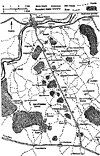
Jumbo Map (very slow: 401K)
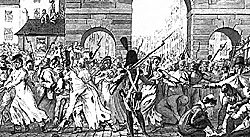
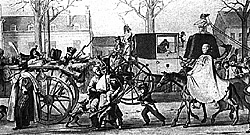
Pictures Of Russian Prisoners From Montmiral escorted Through Paris, and French wounded arriving in Paris. By Delecluze Sources:
FootNotes:
[1] Houssaye and Chandler say 3,000 prisoners while Lachouque claims 1,800.
[2] As previously seen, Yorck's Corps included at least 7,000 men and Sacken's three corps at Montmirail numbered nearly15,700.
[3] Lachouque, The Anatomy of Glory,p.356.
The Battle of Chateau-Thierry as per the Prussian accounts
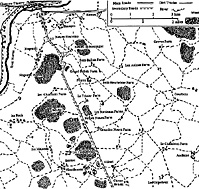
Jumbo Map (very slow: 506K)
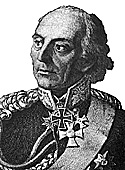
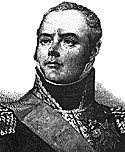
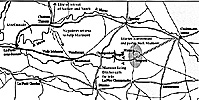 Map #3 showing the strategic situation at the end of the day after Sacken and Yorck retreated across the Marne. Part of Napolions Forces Pursued the defeated Allies, but in the east, near Etoges, Marshal Marmont was pushed back by a reinforced Blucher and called for help
Map #3 showing the strategic situation at the end of the day after Sacken and Yorck retreated across the Marne. Part of Napolions Forces Pursued the defeated Allies, but in the east, near Etoges, Marshal Marmont was pushed back by a reinforced Blucher and called for help
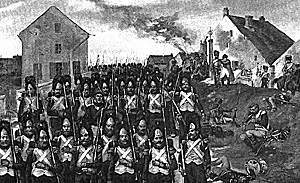 Picture "The Guard - Campaign of France" by A. Bligny
Picture "The Guard - Campaign of France" by A. Bligny
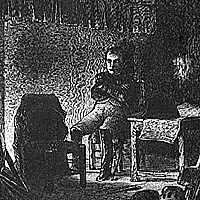 With the escape of the Allies over the Marne bridge, the battle effectively ended. According to Sporschil, the Allies lost about 2,000 men and the French lost about 400 men. [16] Von Damitz gives the Prussian losses at 22 officers and 1,229 other ranks dead and wounded. He also states that three guns were lost. He puts the Russian losses at from 1,200 to 1,500 men. [17]
With the escape of the Allies over the Marne bridge, the battle effectively ended. According to Sporschil, the Allies lost about 2,000 men and the French lost about 400 men. [16] Von Damitz gives the Prussian losses at 22 officers and 1,229 other ranks dead and wounded. He also states that three guns were lost. He puts the Russian losses at from 1,200 to 1,500 men. [17]
Footnotes
[1]. de Vauconcourt, Vol. I, p. 183.
[2]. von Damitz, Vol. II, p.135.
[3]. Ibid, Vol. II,p.135 and Koch, Vol.I. p.248.
[4]. Koch, Vol I, p.248.
[5]. von Damitz is probably refering to the service squadrons that operated as Napoleon's guard, and were commanded by Guyot, von Damitz, Vol. II,p.136.
[6]. von Damitz, Vol. II, p. 138.
[7]. deVauconcourt, Vol. I, p .182.
[8]. vonDamitz, Vol. II, p. 139.
[9]. Sporschil, Vol. II, p. 402.
[10]. de Vauconcourt, Vol. II, p. 182. 11.von Damitz, Vol. II, p. 141.
[12]. Heidenreich was a brigade commanderin the Russian 18th Division.
[13]. Sporschil, Vol. II, p. 403.
[14]. von Damitz, Vol. II, p. 143.
[15]. These units were drawn from the Prussian 2nd brigade.
Bibliography:
von Damitz, K., Geschichte des Feldzuges von 1814 in dem ostlichen undnordlichen Frankreich bis zur Einnahmevon Paris, 1842, Berlin, E. S. Mittler.
Koch, F., Memoirs pour servir al'Histoire de la Campagne de 1814,1819,Paris, Chez Magimel.
Plotho, C., Der Kreig in Deutschland und Frankreich in den jahren 1813 und 1814, 1817, Berlin, Carl Friederich Amelang.
Sporschil, J. Die Grosse Chronik, Geschichte des Kreiges des VerbundetenEuropa's gegen Napoleon Bonaparte, inden Jahren 1813, 1814, und 1815,1841,Braunschweig, George Westerman.
16. Sporschil, Vol. II, p. 404. 17.von Damitz, Vol. II, p. 46.
Part I: Opening Situation
Part II: Battle of Champaubert
Part III: Battle of Montmirail
Part IV: Battle of Chateau Thierry
Back to Empire, Eagles, & Lions Table of Contents Vol. 2 No. 10
Back to EEL List of Issues
Back to MagWeb Master Magazine List
© Copyright 1995 by Emperor's Headquarters
Other military history articles and gaming articles are available at http://www.magweb.com
